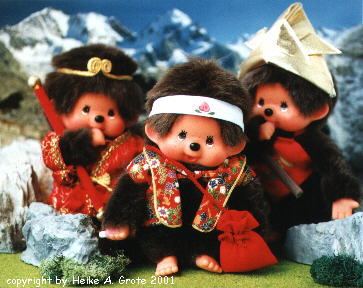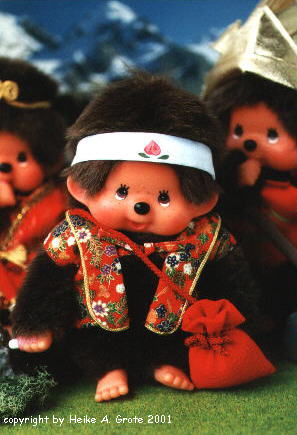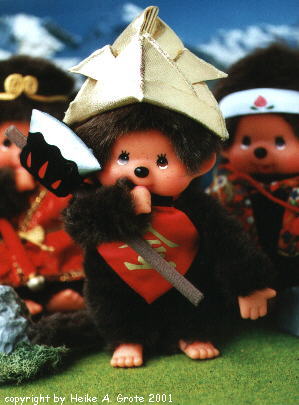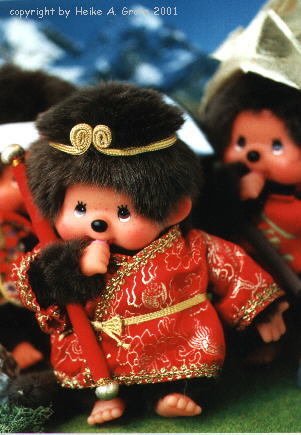Asian Legends

These Monchhichis show three figures out of the chinese and japanese mythology. On this page I tell you the story of those three guys. I always try to get informations about the background of the Monchhichis which wear special clothes. In this case I got some input from different sources. I want to thank Wing and Sekiguchi for giving me informations. I also used the internet as source. Thanks again.
Heike

This is Momotaro. His origin is an old japanese story:
Momotaro
Long ago in a certain part of Japan there was an old man who lived happily with his wife. They were poor and worked hard, and they only had one complaint-- in all their years of marriage, they had never been blessed with children.
One spring morning the old woman was washing clothes at the edge of the river when she saw a large peach tumbling along through the current. She called to it to leave the rough water and come to the still water, the sweet water at her feet. When it did she scooped it up, thinking it would make a fine treat for the old man's supper.
Of course the old man was pleased to see ripe fruit that early in the year. But when he cut it open there was no pit. Instead he found the baby boy they had been praying for so many years.
 In their excitement the old couple forgot the peach completely. Or almost completely-- when it was time to give the boy a name, they called him Momotaro.
In their excitement the old couple forgot the peach completely. Or almost completely-- when it was time to give the boy a name, they called him Momotaro.
As Momotaro grew he became quite strong, considerate, and attentive-- attentive enough that he was still only a boy when he began to hear stories of the wild oni and their raids against the people on the coast. And it was not much longer before he told his parents he had decided to go and subdue the oni. Much as they loved him and wanted to protect him, the old couple knew Momotaro was not a gift they could keep to themselves. The old man tied a hachimaki around Momotaro's forehead to keep the sweat and hair out of his eyes as he fought, and the old woman made him some millet dumplings called kibidango to eat on his way.
Momotaro knew the onilived on an island called Onigashima, so he started walking toward the coast. Before long, he heard panting and turned to see a dog coming up behind him.
"Momotaro," barked the dog, "Where are you going?"
"To Onigashima, to subdue the oni."
"That sounds dangerous."
Momotaro didn't answer, so the dog continued:
"If you'll give me some kibidango I'll follow you."
After eating, the two set off again, with the dog following close behind Momotaro. Before too long the dog began barking, and Momotaro looked up to see a monkey swinging down from a tree.
"Momotaro! Where are you going?"
"To Onigashima, to subdue the oni."
"That sounds interesting. If you'll give me some kibidango I'll go with you."
Momotaro tossed him a few dumplings, and they set off again. The monkey suggested that he ride the dog, but they were soon separated and walked along with Momotaro between them. After a while they passed through a small clearing, and a pheasant swooped down to earth just ahead of the little group.
"Momotaro, Momotaro. Where are you going?"
"To Onigashima, to subdue the oni."
"That's good! Let me show you the way."
Momotaro offered some kibidango. The pheasant took one, then flew off a little to the north. Momotaro, the dog and the monkey followed on the ground.
In a few days they reached the coast and explained their mission to the farmers and fishermen there. No one volunteered to go along, but they did provide a boat and food for the voyage. The group put to sea with the pheasant, as always, leading the way.
The weather was good, and early the second day at sea, the pheasant dropped to the deck at Momotaro's feet to report.
"Momotaro! Onigashima is on the horizon straight ahead. Shall I go check their defenses while the ship proceeds?"
"Please do."
When the pheasant returned, Momotaro, the dog and the monkey had also spotted the island, and the dog said he could see flags flying above the wooden fortress. The pheasant reported that they would be safe approaching the front gate, since the oni seemed to be having a party and had not posted anyone in the watchtower.
When they arrived at the island, Momotaro's forces were in fact able to approach the gate unchallenged. The monkey quickly climbed over the gate, unlatched it, and and let his companions enter.
Most of the oni were sleeping, so the dog barked loudly to wake them, and the fight began.
The monkey immediately leapt at the first oni to rise, clawing first at his back, then at his throat. Fiercely pecking at the eyes, ears and noses of the enemy, the pheasant rose in the air when possible to shout warnings and encouragement to his companions. The dog snapped at all the legs he could find, but soon only heels were within reach; the oni were all running to climb the stockade, or were cowering behind stolen bales of rice.
The oni chieftain finally appeared. He was not at all sure what was happening, but he was angry and quite ready to fight. Holding a huge, iron-studded club high above his curly head, the chieftain strode resolutely toward Momotaro. The dog, monkey and pheasant respectfully let him pass. But the other oni refused to be rallied by their leader's brave approach to the boy's position.
Momotaro was ready to parry the blow of the club with his fan. He quickly subdued the chieftain, and had finished binding the huge thumbs together before the oni had gathered the breath and the presence of mind to beg for mercy.
"Please, Momotaro, spare our lives! We meant no harm."
"Oni live only to do harm."
"No. You have taught us well. We will abandon piracy and pillaging, and never bother your islands again."
"What will you do?"
"We could be merchants-- maybe fishermen. We have good boats and strong backs, and my men are not afraid of hard work."
In the end it was decided the oni would live by farming Onigashima. The chieftain had his underlings load chests of treasure and booty into Momotaro's boat. The oni kept only enough rice to use for seed. Several captive maidens who wished to return to their homes also left with Momotaro. Guided by the pheasant, the party returned to Japan, and Momotaro went back to his own village to care for his parents as they grew older.
source :
Momotaro homepage

Here you can see Kintaro who is a figure of an old japanese myth.
"Kin" means "Gold". "Taro" is a very popular boy's name, meaning simply "Boy". Therefore, "Kintaro" can be translated as "Golden Boy". Here you can read his story :
At that time there also lived in today's Kaisei Town a powerful and influential Samurai (warrior) called Mr. Sakata. Mr. Sakata loved the daughter and decided to get married with her. Since her family was very rich, her wedding parade was luxurious and gorgeous, carrying trousseaus and gifts to her new family.
Unfortunately, for certain reasons, she was forced to go back to her native house at Jizodo, when she was pregnant. Soon after she got home, she had a rotund and bouncing baby boy. She named him "Kintaro". "Shiman-choja" family took very good care of "Kintaro".
"Kintaro" was a good, charming boy with clear eyes and rosy-cheeks. Strong and active boy from the beginning, Kintaro played as jumping up and down "Kabuto-ishi" rock and "Taiko-ishi" rock in the nearby rice field.
As he grew up, he became a bossy boy among children around and played all day long in the steep mountains such as Mt. Ashigara and Mt. Kintoki.
As he trained himself in the mountains, he became so strong that he could throw a bear, the strongest in the mountain forests, in "Sumo" wrestling.
Kintaro changed his name to "Kintoki" after grown up into a man. He became a big, strong and handsome young man, having a good reputation among surrounding villages.
Around that time, there lived in Kyoto, the capital, the strongest chief "Samurai" (warrior) called Yorimitsu Minamoto. He happened to come across to Ashigara pass area on his way back from eastern countries. When he and his troop of retainers came to Jizodo, they took a rest, and were surprised to find out Kintaro, a strong and good-looking young man in such a countryside.
Yorimitsu thought, "It must be by God's providence that I have met with this boy." and recommend him to become his retainer.
Kintoki was extremely happy and, no doubt, accepted Yorimitsu's offer to become a retainer of the most famous Samurai in Kyoto.
Mr. Kintoki Sakata went up to Kyoto, studied harder, and trained himself in martial arts to become one of the four Yorimitsu's strongest retainers.
Even now, when a boy is born, parents decorate his room with "Kintaro" doll on May 5 (Boy's day: By the way, March 3 is Girl's day), expecting that he will have similar good luck to become "strong and gentle" Kintaro.
source
: Kintaro Homepage

His name is Songoku
. He is a the monkey king, from the famous chinese myth "journey to the west".Songoku
The story is about the monkey king and other four braves who tried to went somewhere else in the west of China to get a book which can make the whole world to be peaceful! There are many difficulties and dangers during the journey.

back to My Monchhichi Photo Gallery